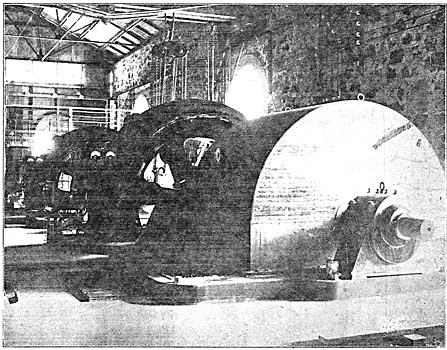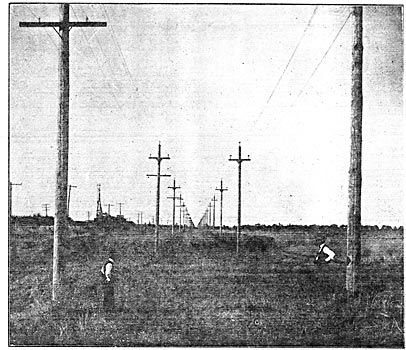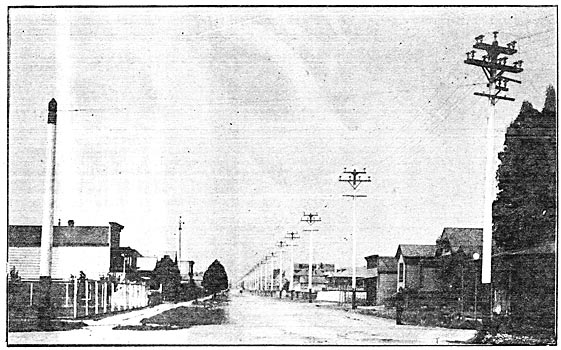[Trade Journal]
Publication: The Journal of Electricity, Power and Gas
San Francisco, CA, United States
vol. 11, no. 7, p. 168-173, col. 1-2
TELEPHONE SERVICE IN CONNECTION WITH LONG DISTANCE POWER TRANSMISSION.
BY T. E. THEBERATH.
AS short a time as five years ago 5000 or 10,000 volts was considered very high potential and twenty miles almost the limiting distance of transmission and telephone service over wires strung on the power line was not always of the best. In the construction of the telephone line the matter of insulation was not considered of very great importance. Porcelain knobs or pony insulators were considered sufficient and good enough for all practical purposes. The transposition of the wires to neutralize inductance from the power wires was considered to he of great importance, and every one had his own method. Transpositions were put in every five, ten, or twenty poles, but with no regard to the current on the power line, whether two or three phase, or whether the power line was spiraled or not.
The inductance on the telephone wires is the result of the magnetic field surrounding the power wires and as the receiver of a telephone is a very sensitive current detector, whose operation depends upon most minute current impulses, it is seen at once that electrical engineers have a delicate problem before them.
| |||
| Six Thousand Horsepower in Two Units. |
It is not the object of this paper to lay down definite rules for constructing telephone lines on power lines, but to mention some of the experiences encountered, with the hope of bringing out a discussion on the subject and of getting others started on a line of investigation which will assist in overcoming the difficulties encountered in one of the most important adjuncts to the successful transmission of power over long distances. In this paper, therefore, the experiences related will be restricted to a few lines which have come under my personal supervision and construction. The first case is a line of about eight miles in length, constructed some five years ago, of No. 10 iron wire strung on brackets one above the other on the same side of the poles, about 6 feet below two two-phase four-wire circuits, carrying a potential of 5000 volts. The telephone wires were transposed every five poles and the power circuits were spiraled with reference to mutual inductance between the circuits. The telephones were of the series type with low resistance bells, in fact, the system presented a good example of what should be avoided in telephone line construction . Placing t h e wires one above the other on the same side of the pole makes it almost impossible to balance the electromotive forces of inductance against o n e an other by the transposition of the wires. The series instrument also makes it difficult to balance the line if a number of phones are on the same line. This line gave service but of a very unsatisfactory nature.
| |||
| A Double Poleline Extends From Colgate to Oakland, A Distance of 142 Miles. |
The next line, which was constructed some three years ago, is nineteen miles in length and consists of two wires of about No. 12 gauge, strung on the two pole pins of a six-pin crossarm 5 feet below two two-phase circuits, carrying a potential of 16,000 volts. The insulators are double-petticoat deep-groove glass, with transpositions every tenth pole, the poles being set forty-four poles to the mile. Locke one-piece transposition insulators were used, and after the line was completed it was found that the teamster who distributed the insulators was not educated to the importance of transpositions at regular intervals, and had dropped a pair of transposition insulators when-ever he happened to think of them. The linemen came along and cut in transpositions wherever they found the insulators for that purpose.
| |||
| Piedmont Substation of the Oakland Transit Company. |
Another amusing, as well as interesting incident occurred in the construction of this line. At a point six miles from the power house the wire was looped around the transposition insulators, leaving an open circuit in the line with two short circuited loops. It had been arranged that in case it was found impossible to communicate over the metallic circuit that both wires should be connected to one binding post and the other to ground. With the latter condition a communication was held with a party on the Sunset line. The Sunset line, however, paralleled the lower end of the line for twelve miles, but the open circuit was bridged by the power wires so that it was a case of induction from the Sunset line to the power wires (which were not carrying current at the time), and then by a second induction back on the upper end of the telephone line. The open circuit was located the following clay and the error in the transpositions corrected.
| |||
| Through Oaklan A Single Pole Line Carries Both the Bay Counties' Lines. |
The power circuits, in this instance, consisted of two four-wire two-phase circuits for a distance of seven miles, one circuit having a half turn at the three and one-half mile point and the other going straight through for the whole nineteen miles. This telephone line gave good service, although there was a constant hum which, however, was not sufficient to interfere with the working of the line. The power line has since been extended so that the two four-wire circuits now run the full length of the nineteen miles. In extending the second line the power wires were spiralled at three points with a quarter turn in opposite directions, so as to give four divisions in the twelve miles of three miles each. This was done to reduce the inductance on the Sunset line, which was strung on the six-pin arm of this line alongside of the private line. The Sunset line was originally transposed every ten poles, intermediate to the transpositions of the private line; but as considerable trouble had been experienced on this telephone line it was finally transposed every other pole. The most benefit, however, was derived on this line when the power wires were spiralled.
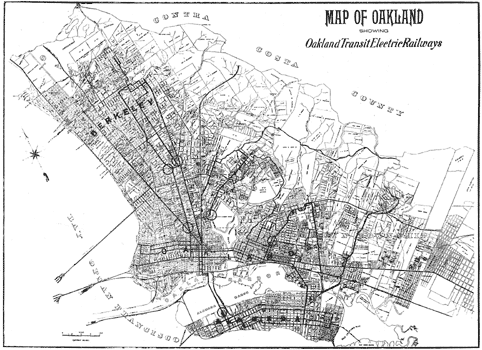 |
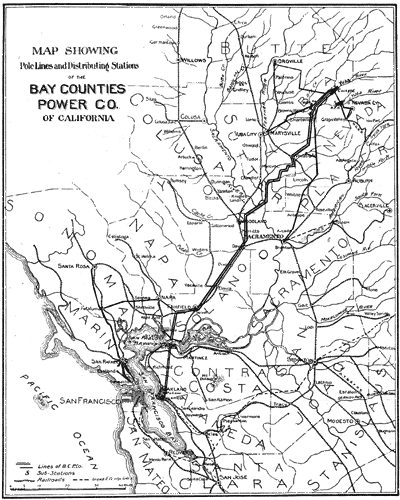 |
This experience seems to demonstrate that the proper spiralling of the power wires is of more importance than the transposition of the telephone wires. So that in planning the construction of the telephone line for the sixty mile line from the power house to Sacramento, it was decided to try an experiment on entirely new lines. The power wires were arranged to form two circuits on the six points of a hexagon with 2-foot sides, or two interlaced triangles of 42-inch sides. This undoubtedly gives a perfect arrangement for neutrality of field, but each circuit was given one-third of a turn in opposite directions at every mile so that each circuit made one-third of a revolution at each mile ill reference to earth, and two-thirds of a turn in reference to each other. The telephone line was carried through on the two pole pins of a six-pin arm 5 feet below the power wires, and without a transposition, for the entire length. No transpositions were considered necessary for the reason that the power wires were spiralled and the inductance should neutralize itself on any paralleled circuit, provided that the number of transpositions divide the line into a number of parts forming groups of four or three, depending on the line current being either two or three phase. The reason for this is obvious if we consider for instance a three-phase line, the currents of which are 120 degrees apart, and calling the wires A, B and C. With one-third of a turn each mile the A wire will occupy a certain pin for the first mile. In the second mile the B wire will be on this pin, and in the third mile the C wire will take this position. The three electromotive forces of inductance from A, B and C impressed upon a parallel wire will also be at 120 degrees from each other and their sum will be zero in every three miles of wire. The same reasoning holds good for two-phase lines with this difference: the line being four wires, each turn is one-quarter, and it takes four miles to neutralize the electromotive forces of inductance. If a line has been definitely surveyed and is to remain of fixed length, it is a very easy matter to divide the line into an equal number of parts, in groups of four or three, in accordance with the phases. It is not always the case, however, that the exact length of the line is known before actual construction is commenced. This was the case with the Sacramento line, as well as the bay line of the Bay Counties' Power Company. For this reason the power wires were transposed every mile and the unbalanced end, if any, can be taken care of by properly transposing the telephone wires or by dividing the last end of the power line into either four or three equal parts. No attempt has been made in the bay line to correct for any equal end, but as the line is 142 miles in length, the unbalanced end is such a small fraction of the total that no serious effects are experienced.
| |||
| Gold Dredgers Are Noteworthy Consumers of Bay Counties' Power in the Feather River District. |
| |||
| One of the 2000-Kilowatt Stanley Generators in the Colgate Power House. |
| |||
| Some of the Many Different Types of These Gold Dredgers Are Here Shown in Miniature. |
The telephone wire on the hay line is No. 4 stranded aluminum cable for a distance of eighty miles and three-strand aluminum cable for the balance of the distance. Insulators of double-petticoat, double-groove glass, on two pins, equidistant from the pole, on a six-pin arm 5 feet below the power wires, which carry current at 40,000 volts, connected with neutral grounded. When everything is in perfect order the line is absolutely quiet. Some trouble has been experienced with grounds on the telephone wires, which reduce the line at once to single-wire circuit with ground return and unbalances the line so that it is very noisy.
Some peculiar results have been obtained with a Weston alternating-current voltmeter on this line. The line talked very well but there was considerable hum. Connecting the voltmeter across the wires at the Oakland end no deflection of needle was obtained. From one wire to ground the reading was zero, but from the other wire 124 volts was indicated to ground. At the same time readings were taken at the power house end with no voltage between wires and seventy-two volts between either wire and ground.
These are very curious results, but any voltmeter with a finite resistance is useless in obtaining the existing conditions, as the instrument practically grounds the system when connected. A static voltmeter should be used for this purpose. Other readings were taken on other lines, but are of no further value than food for reflection to try and explain the why and the wherefore without knowing the true conditions with the assistance of a static voltmeter, or some other method of determining the voltage to earth without grounding the system.
*Submitted for discussion at the Fifth Annual Convention of the Pacific Coast Electric Transmission Association, San Jose, Cal., June 18-19, 1901.

